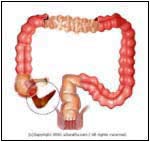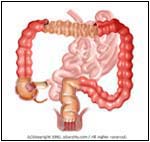Description
* The appendix is a collection of lymphatic tissue (tissue that is part of the body's immune/defense system). The appendix, connected to the colon, is a few inches in length and has a lumen (a hollow portion). Appendicitis is thought to occur when this lumen becomes obstructed.
Symptoms
* Child refuses to run or jump because of abdominal pain
* Flank, pelvic, or rectal pain may occur
* Pain usually begins near belly button
* Pain then localizes to the right lower abdomen
* Nausea/vomiting (occurs after pain starts and not before)
* Loss of appetite
* Urinary pain/frequency may occur
Cause
* Fecal obstruction
* Parasitic worm obstruction
* Tumor obstruction
* Viral infection of appendix
* Barium obstruction (from a medical test)
How The Diagnosis Is Made
* Examination:
1. Fever
2. Fast heart rate
3. Rebound tenderness in right lower abdomen (pain is worse when doctor releases hand from abdomen)
4. Flank, rectal, or pelvic pain if appendix is in unusual position
5. Rigid or diffuse abdominal tenderness if appendix perforates
* If the diagnosis is still unclear after all the tests and procedures are done, many doctors will admit a child to the hospital for observation and repeated physical exams over a period of 12 to 24 hours.
* Laboratory:
1. Laboratory tests may be unreliable in some (e.g., older patients with certain drugs/medications).
2. Elevated white blood cell count
3. Urinalysis to check for other causes
* Imaging:
1. Abdominal X-ray (KUB), ultrasound, or barium enemas may help in certain cases but are not diagnostic.
2. Spiral CT scan is now very sensitive in detecting appendicitis

Treatment
* Surgical removal of the appendix (appendectomy) as soon as possible, unless the doctor feels a mass on the outside.
* The surgery, called an "appendectomy," can be done through a small incision in the abdomen or with a laparoscope, a small device with a camera that lets the surgeon operate remotely. The decision about what kind of procedure is needed depends upon each patient's circumstances.
* Because the complications of an untreated appendix infection are serious, children often have an appendectomy even if the diagnosis is not entirely certain. In cases where the surgeon finds that the appendix is not infected, it is usually removed anyway, so that there is not question of a possible infection in the future.
* If mass is felt on the outside, patients are treated with IV antibiotics and fluids, and appendectomy is done when the patient is more stable.
Miscellaneous
* Special Considerations:
1. There may be unusual presentations, such as pain in rectum only and no abdominal pain, if the appendix is pointed backwards. Therefore, appendicitis must be considered as a possible diagnosis in all types of pelvic, rectal, and back pain, as well as with abdominal pain.
2. In infants with fever, Diarrhea, vomiting, and abdominal pain appendicitis should always be considered.
3. In pregnant women, appendicitis occurs in 1 in every 1000 pregnancies, and the enlarged uterus may push appendix to the right upper abdomen, causing pain in this area.
4. If an infected appendix is not removed in time, it may break open, or "rupture." This is a serious and potentially life-threatening complication. Children with a ruptured appendix will usually require a week or more of IV antibiotics.
* Seek emergency medical care immediately.
Similar Conditions
* Mesenteric adenitis
* Severe constipation
* Urinary tract infection
* Pneumonia
* Acute gastroenteritis
* Meckel's diverticulitis
* Intussusception
* Ovarian lesions




No comments:
Post a Comment